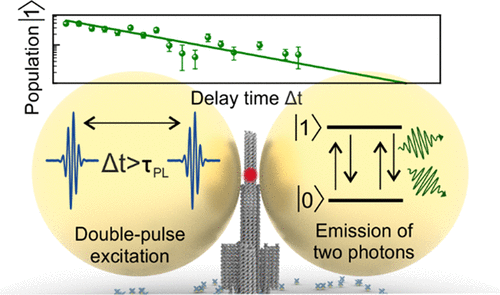当前位置:
X-MOL 学术
›
Nano Lett.
›
论文详情
Our official English website, www.x-mol.net, welcomes your feedback! (Note: you will need to create a separate account there.)
Ultrafast Single-Molecule Fluorescence Measured by Femtosecond Double-Pulse Excitation Photon Antibunching.
Nano Letters ( IF 10.8 ) Pub Date : 2019-12-23 , DOI: 10.1021/acs.nanolett.9b04354 J Schedlbauer 1 , P Wilhelm 1 , L Grabenhorst 2 , M E Federl 1 , B Lalkens 3 , F Hinderer 4 , U Scherf 5 , S Höger 4 , P Tinnefeld 2 , S Bange 1 , J Vogelsang 1 , J M Lupton 1
Nano Letters ( IF 10.8 ) Pub Date : 2019-12-23 , DOI: 10.1021/acs.nanolett.9b04354 J Schedlbauer 1 , P Wilhelm 1 , L Grabenhorst 2 , M E Federl 1 , B Lalkens 3 , F Hinderer 4 , U Scherf 5 , S Höger 4 , P Tinnefeld 2 , S Bange 1 , J Vogelsang 1 , J M Lupton 1
Affiliation

|
Most measurements of fluorescence lifetimes on the single-molecule level are carried out using avalanche photon diodes (APDs). These single-photon counters are inherently slow, and their response shows a strong dependence on photon energy, which can make reconvolution of the instrument response function (IRF) challenging. An ultrafast time resolution in single-molecule fluorescence is crucial, e.g., in determining donor lifetimes in donor-acceptor couples which undergo energy transfer, or in plasmonic antenna structures, where the radiative rate and non-radiative rates are enhanced. We introduce a femtosecond double-excitation (FeDEx) photon correlation technique, which measures the degree of photon antibunching as a function of time delay between two excitation pulses. In this boxcar integration, the time resolution of fluorescence transients is limited solely by the laser pulse length and is independent of the detector IRF. The versatility of the technique is demonstrated with a custom-made donor-acceptor complex with one donor and two acceptors and with single dye molecules positioned accurately between two gold nanoparticles using DNA origami. The latter structures show ∼75-fold radiative-rate enhancement and fluorescence lifetimes down to 19 ps, which is measured without the need for any reconvolution. With the potential of measuring subpicosecond fluorescence lifetimes, plasmonic antenna structures can now be optimized further.
中文翻译:

飞秒双脉冲激发光子反聚束法测量的超快单分子荧光。
在单分子水平上大多数荧光寿命的测量是使用雪崩光子二极管(APD)进行的。这些单光子计数器的固有速度很慢,并且它们的响应显示出对光子能量的强烈依赖性,这可能使仪器响应函数(IRF)的卷积变得具有挑战性。单分子荧光中超快的时间分辨率至关重要,例如,在确定经历能量转移的供体-受体对中或在辐射速率和非辐射速率得到增强的等离子天线结构中,确定供体寿命。我们引入了飞秒双激发(FeDEx)光子相关技术,该技术测量光子反聚束程度与两个激发脉冲之间的时间延迟的关系。在这种棚车整合中,荧光瞬变的时间分辨率仅受激光脉冲长度的限制,并且与检测器IRF无关。定制的供体-受体复合物具有一个供体和两个受体,并且使用DNA折纸将单个染料分子精确地定位在两个金纳米粒子之间,证明了该技术的多功能性。后者的结构显示出约75倍的辐射速率增强和低至19 ps的荧光寿命,无需重新卷积即可进行测量。由于具有测量亚皮秒荧光寿命的潜力,现在可以进一步优化等离子体天线结构。定制的供体-受体复合物具有一个供体和两个受体,并且使用DNA折纸将单个染料分子精确地定位在两个金纳米粒子之间,证明了该技术的多功能性。后者的结构显示出约75倍的辐射速率增强和低至19 ps的荧光寿命,无需重新卷积即可进行测量。由于具有测量亚皮秒荧光寿命的潜力,现在可以进一步优化等离子体天线结构。定制的供体-受体复合物具有一个供体和两个受体,并且使用DNA折纸将单个染料分子精确地定位在两个金纳米粒子之间,证明了该技术的多功能性。后者的结构显示出约75倍的辐射速率增强和低至19 ps的荧光寿命,无需重新卷积即可进行测量。由于具有测量亚皮秒荧光寿命的潜力,现在可以进一步优化等离子体天线结构。
更新日期:2020-01-08
中文翻译:

飞秒双脉冲激发光子反聚束法测量的超快单分子荧光。
在单分子水平上大多数荧光寿命的测量是使用雪崩光子二极管(APD)进行的。这些单光子计数器的固有速度很慢,并且它们的响应显示出对光子能量的强烈依赖性,这可能使仪器响应函数(IRF)的卷积变得具有挑战性。单分子荧光中超快的时间分辨率至关重要,例如,在确定经历能量转移的供体-受体对中或在辐射速率和非辐射速率得到增强的等离子天线结构中,确定供体寿命。我们引入了飞秒双激发(FeDEx)光子相关技术,该技术测量光子反聚束程度与两个激发脉冲之间的时间延迟的关系。在这种棚车整合中,荧光瞬变的时间分辨率仅受激光脉冲长度的限制,并且与检测器IRF无关。定制的供体-受体复合物具有一个供体和两个受体,并且使用DNA折纸将单个染料分子精确地定位在两个金纳米粒子之间,证明了该技术的多功能性。后者的结构显示出约75倍的辐射速率增强和低至19 ps的荧光寿命,无需重新卷积即可进行测量。由于具有测量亚皮秒荧光寿命的潜力,现在可以进一步优化等离子体天线结构。定制的供体-受体复合物具有一个供体和两个受体,并且使用DNA折纸将单个染料分子精确地定位在两个金纳米粒子之间,证明了该技术的多功能性。后者的结构显示出约75倍的辐射速率增强和低至19 ps的荧光寿命,无需重新卷积即可进行测量。由于具有测量亚皮秒荧光寿命的潜力,现在可以进一步优化等离子体天线结构。定制的供体-受体复合物具有一个供体和两个受体,并且使用DNA折纸将单个染料分子精确地定位在两个金纳米粒子之间,证明了该技术的多功能性。后者的结构显示出约75倍的辐射速率增强和低至19 ps的荧光寿命,无需重新卷积即可进行测量。由于具有测量亚皮秒荧光寿命的潜力,现在可以进一步优化等离子体天线结构。


























 京公网安备 11010802027423号
京公网安备 11010802027423号